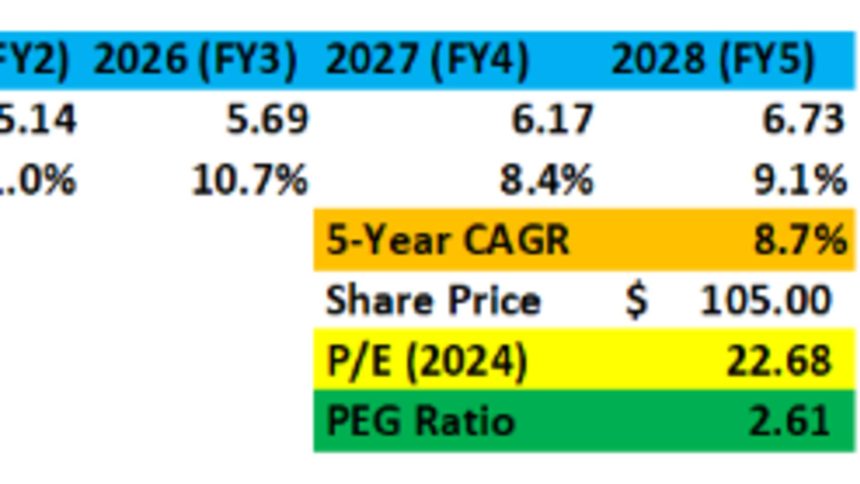Here’s our Club Mailbag email [email protected] — so you send your questions directly to Jim Cramer and his team of analysts. We can’t offer personal investing advice. We will only consider more general questions about the investment process or stocks in the portfolio or related industries. This week’s question: You advise not to buy stocks that have a PEG of over 2, but it seems many of the stocks recommended on the show have a PEG of well over 2, such as Abbott Labs and Eaton. Is this because there are more important considerations than PEG? — Marcia from Washington Determining the value of a stock and what price-per-share you are willing to pay is both an art and a science. The science is coming up with the appropriate estimates and inputs for the financial metrics that you want to use as yardsticks. The art is determining which metric or metrics should carry the most weight in your buy, sell or hold decision-making process. One of the most well-known metrics is the forward price-to-earnings, or P/E, ratio. It takes a company’s stock price and divides it by the next 12 months’ earnings estimates. The PEG ratio, as referenced in the question, takes the price-to-earnings ratio and divides it by a company’s projected long-term earnings growth rate. As a general rule, a PEG ratio of 1 or lower indicates you’re getting future growth at a good value. On the high side, a PEG of 2 or above suggests you may be paying more for future growth than you should be. To be sure, price-to-earnings and PEG ratios are just a couple of metrics in an ocean of different methods to evaluate stocks. While the PEG should be considered, it should only be prioritized when analyzing growth companies. (The PEG of more mature, value-orientated companies, or those not required as part of your investment thesis to deliver strong earnings growth year after year, would be considered less of a factor.) If, for example, your priority is dividend income, you’re going to be far more concerned with the sustainability of that dividend — and therefore factors like cash flow resiliency and the dividend payout ratio — than you are with earnings growth and the PEG ratio. Growth companies get their name from the expectation of substantial earnings growth in the future — to the point at which that expected growth is the only way to possibly justify a high current price-to-earnings valuation. That’s what the PEG ratio attempts to capture. In other words, the P/E on its own does not make a stock look attractive. (However, looking at historical P/Es for a company and how it compares to industry rivals and the broader stock market can be a useful tool.) The added element of the long-term expected earnings growth, which is captured by the PEG ratio, goes to the heart of buying stocks at lower prices and selling them at higher prices later. While there are many factors at play, we believe as fundamental investors that growing companies in the long term are rewarded with higher stock prices. In the case of Abbott Labs , it’s an established health-care company with products already in the market that have significant, resilient demand. For this company, we should concern ourselves more with the current earnings power, and the multiple being put on those earnings, which is currently suppressed versus the historical average, than the PEG ratio of 2.6. Keep in mind that we also collect a dividend to compensate us for any lack of earnings growth. At current levels, about $105 per share, Abbott stock trades at a P/E multiple of 22.7 times forward earnings estimates, which is below its five-year average and only slightly above the S & P 500 and the health-care sector multiples. The annual dividend yield of 2.1% is above the five-year average of 1.6%. These factors outweigh the PEG ratio in our view and are our primary focus right now when it comes to valuing Abbott. It’s also worth noting that Abbott stock has also been unfairly punished recently due to litigation concerns resulting from lawsuits over a life-threatening disease in premature babies called necrotizing enterocolitis (NEC) related to its Similac formula. The overhang started in March after a competitor in the baby formula market lost a major case and was ordered to pay out $60 million to a single family — that’s being appealed. Any type of litigation risk cannot be ignored, however, Abbott has a defensible position because its product had a warning label. Baby formula, especially for premature infants, is also seen as necessary by the medical community. As we reiterated on Wednesday , the market cap Abbott Labs has lost because of litigation fears far exceeds what many analysts think the company could ultimately pay to settle the lawsuits. Eaton also has an elevated PEG of nearly 2.8. But like Abbott, measurable growth is not the sole factor determining our thesis. While valuing the electrical components company at higher levels than seen historically, we think Eaton will beat current estimates due to the strong demand for power solutions in the data centers being revamped and built to handle artificial intelligence workloads. Eaton shares will continue to work as investors continue to gravitate towards secular trends like powering the future. In this case, we’re leaning more heavily on the art than the science. By all metrics, Eaton is richly valued. That’s not up for debate. The art here is looking at the story, taking a worldview, and concluding that investors will continue to value the company at higher levels than they used to because of the opportunities that lie ahead. The earnings estimates don’t account for the promise of this growth, yet. The premium based on current numbers is, in our view, warranted given the positioning of the company relative to the secular growth aspects of its targeted end markets. (See here for a full list of the stocks in ugh.Jim Cramer’s Charitable Trust.) As a subscriber to the CNBC Investing Club with Jim Cramer, you will receive a trade alert before Jim makes a trade. Jim waits 45 minutes after sending a trade alert before buying or selling a stock in his charitable trust’s portfolio. If Jim has talked about a stock on CNBC TV, he waits 72 hours after issuing the trade alert before executing the trade. THE ABOVE INVESTING CLUB INFORMATION IS SUBJECT TO OUR TERMS AND CONDITIONS AND PRIVACY POLICY , TOGETHER WITH OUR DISCLAIMER . NO FIDUCIARY OBLIGATION OR DUTY EXISTS, OR IS CREATED, BY VIRTUE OF YOUR RECEIPT OF ANY INFORMATION PROVIDED IN CONNECTION WITH THE INVESTING CLUB. NO SPECIFIC OUTCOME OR PROFIT IS GUARANTEED.
Here’s our Club Mailbag email [email protected] — so you send your questions directly to Jim Cramer and his team of analysts. We can’t offer personal investing advice. We will only consider more general questions about the investment process or stocks in the portfolio or related industries.
This week’s question: You advise not to buy stocks that have a PEG of over 2, but it seems many of the stocks recommended on the show have a PEG of well over 2, such as Abbott Labs and Eaton. Is this because there are more important considerations than PEG? — Marcia from Washington
Read the full article here
News Room




